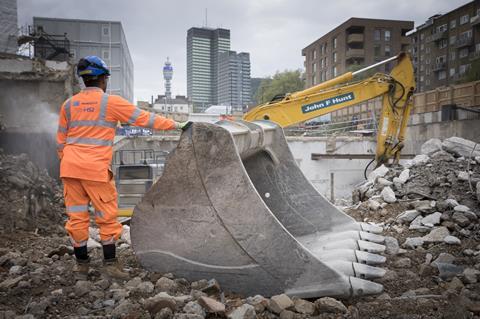Modern materials are ŌĆśnowhere nearŌĆÖ as reusable as those used in traditional construction
The use of modern methods of construction (MMC) is making it much harder to reuse materials when a building is demolished, built environment experts have warned.
Howard Button, chief executive of the National Federation of Demolition Contractors (NFDC), said composite materials used in MMC projects are ŌĆ£nowhere near as recoverableŌĆØ as traditional materials found in older buildings such as Victorian housing.
Several industry groups have campaigned for more widespread reuse of materials such as steel and timber, a practice which is increasingly seen as an important way to reduce embodied carbon during the construction of demolish-and-rebuild projects.

Last week, the UK Green ║├╔½Ž╚╔·TV Council (UKGBC) published a report calling for the establishment of an agreed metric for reporting the carbon savings of material reuse.
Climate campaign group Architects Declare, which is being backed by practices including AHMM, Haworth Tompkins and DSDHA, urges signatories to work towards a circular economy in the built environment by reusing as many materials as possible from buildings to reduce waste to a minimum.
The same groups have also championed MMC approaches such as modular construction as necessary to get the industry towards net zero emissions.
But Button said composite materials, which are glued together and cannot easily separated and reverted into source materials, are a ŌĆ£problem for the [demolition] industryŌĆØ.
ŌĆ£If we really want a circular economy weŌĆÖve got to look at what we put into it to ensure we can take it out in the future,ŌĆØ he said.
>> Also see: Why are we struggling to make modular work?
>> On-demand webinar | What can the industry do to best combat the materials shortages?
>> Materials database is a passport for reuse
Rachel Hoolahan, architect and sustainability coordinator at Shoreditch practice Orms, said the specification of composite materials by designers without factoring in their viability for future reuse is ŌĆ£accidentalŌĆØ.
ŌĆ£They just havenŌĆÖt considered it. TheyŌĆÖre just trying to do their job of making the best possible building for their clients but I think sometimes they just donŌĆÖt really realise the true impact of it,ŌĆØ she said.
ŌĆØA very easy thing to fall into is you could think youŌĆÖre doing the right thing by glueing materials together, but actually inadvertently just sticking it all so much together that we canŌĆÖt possibly take it apart.ŌĆØ
Robin Powell, former managing director of demolition firm DSM, said builders ŌĆ£donŌĆÖt think of demolition at allŌĆØ when designing and constructing buildings.
ŌĆ£I find time and time again that people that were designing both the components and the complete building that the last thing on their minds was recycling and reuse of the component parts.ŌĆØ
He said that ŌĆ£virtually nothingŌĆØ from an MMC student accommodation block at Birmingham City University could be reused after it was demolished by DSM in 2020, and the volume of material which could be recycled had dropped by 30% compared with a traditionally built structure.
Reusing materials has also become significantly harder in recent years because of tightening building regulations, including those which set minimum standards for thermal efficiency.
ŌĆ£Years ago all [demolition] contractors used to take steel and sell it back into the building trade,ŌĆØ Button said.
ŌĆ£That sort of reuse of steel stopped when a lot of the building code became so tight and so specific, it was very difficult to find second hand steel that met the code and could be certified.ŌĆØ
Just 1% of building materials in north west Europe are reused following their first application, according to figures from the FCRBE, an European Union project aiming to increase material reuse. As much as 30% of a Victorian house can be reused following demolition, including bricks and timbers, according to Button.
Ben Griffiths, operations director of demolition firm Rye Demolition, said that reusing materials such as steel is often ŌĆ£more hassle than itŌĆÖs worth because of the requirementsŌĆØ and said clients often see material audits on rebuild projects as a ŌĆ£BREEAM box tickŌĆØ.
Last year, Orms proposed a new system for gathering information about materials in buildings to decide whether they can be reused. The practice said architects could use their phones to scan QR codes imprinted on materials within buildings to access recorded data including fire ratings and maintenance information.




























No comments yet